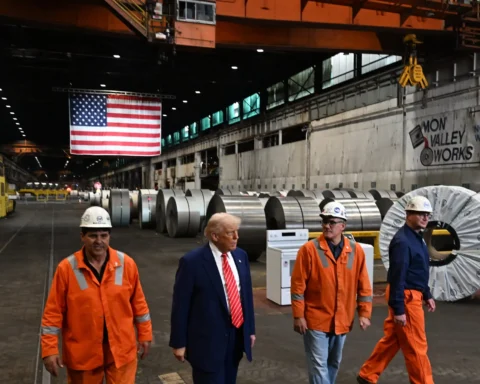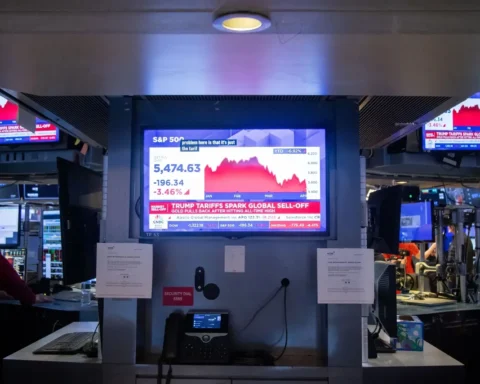By Shannon Pettypiece and Rob Wile
President Donald Trump’s ambitious plan to broker dozens of trade deals with some of the United States’ closest trading partners has begun to show cracks as the clock on his 90-day pause for most country-specific tariffs winds down to just over one month.
While some of the fissures are self-inflicted, like recent threats of tariffs against the European Union and higher duties on steel imports, a fresh set of court rulings questioning the president’s tariffs-granting authority now hangs over his entire push to reset U.S. trade relations.
On Friday, Trump announced a plan to double steel and aluminum tariffs to 50%. That followed new accusations against China of violating the handshake agreement the two countries had struck in early May during talks in Geneva.
Over the weekend, the E.U. responded to the steel and aluminum tariffs by warning it was preparing to take countermeasures against U.S. goods. China, meanwhile, issued its own accusation against the United States over the weekend, alleging it had undermined the Geneva pact by imposing new export controls on computer chips.
The increasingly public disagreements over trade aren’t unexpected despite Trump’s ambitious timeline and the optimistic rhetoric from White House officials, former trade negotiators said.
Typically, it can take months, if not years, for the United States to work out a trade agreement with another country. Many of the remaining trade barriers on U.S. goods are there for a reason — such as to protect a key local industry in a country or in response to a separate barrier the United States has put up to protect its own goods.
“It’s going to be a long, drawn-out negotiation,” said Warren Maruyama, who worked on trade deals during the George W. Bush administration as general counsel for the Office of the U.S. Trade Representative. “You could hope that your trading partner is stupid and will agree to a bad deal.
But, for the most part, most foreign trade negotiators are quite good, and it’s typically a pretty brutal head-to-head negotiation between two sophisticated countries who have been doing trade deals for decades.”
The increased tensions Trump has injected in recent weeks could also be adding to the complexities U.S. officials face when they sit across from their foreign counterparts, who may feel they don’t have a clear understanding of what the United States is offering, where its red lines are or what it is trying to achieve from a trade agreement.
“I think it’s going to be a challenge for a number of our trading partners, who feel like they are negotiating with a gun to their heads and negotiating with an administration that is not reliable,” said Alex Jacquez, who worked for the National Economic Council during the Biden administration.
“You are just negotiating in a climate in which you do not know what your counterpart wants at the end of the day or is going to do in the interim,” Jacquez said. “And so there’s not much of an incentive to come to the table if you are just going to get whacked for doing so.”
Still, U.S. officials say they are close to making additional deals over the next month. Reuters reported that by Wednesday, the Trump administration wants countries to submit their best trade proposals, including offers to purchase U.S. industrial and agricultural goods, to speed along negotiations, according to a draft letter to negotiating partners Reuters said it had reviewed.
“Productive negotiations with many key trading partners continue at a rapid pace. It is in all parties’ interest to take stock of progress and assess any next steps,” an official with the trade representative’s office said in response to the report.
Still, 60 days in, just one tentative trade agreement has been reached, with the United Kingdom, though nothing yet has officially been formalized. And Trump suggested last month that he may just send out letters informing most countries of their tariff rates after the 90-day pause because the United States lacks the bandwidth to negotiate with each country individually.
Here’s where things stand now.
China
Last month, Trump said he was pausing the massive tariffs he’d imposed on China since April for 90 days, after top U.S. and Chinese officials agreed at a meeting in Switzerland to discuss their trade concerns and de-escalate tensions.
Cracks in that detente began to appear just a week after the tariff pause. Chinese officials accused the United States of undermining the trade truce they’d reached after the U.S. Commerce Department warned companies about using Chinese chips, including those by chipmaker Huawei Technologies. Chinese officials said the guidance was“discriminatory” and “market distorting.”
Last week, Trump accused China of not holding up its end of the truce, posting on social media: “Everybody was happy! That is the good news!!! The bad news is that China, perhaps not surprisingly to some, HAS TOTALLY VIOLATED ITS AGREEMENT WITH US. So much for being Mr. NICE GUY!”
U.S. Trade Representative Jamieson Greer said in an interview on CNBC last week that the Chinese had been “slowrolling” an agreement made in Switzerland to unwind non-tariff retaliatory countermeasures it had put in place, like restrictions by the Chinese on shipments of rare earth metals.
Treasury Secretary Scott Bessent said Sunday on CBS’ “Face the Nation”: “What China is doing is holding back products essential for industrial supply chains in India and Europe. That is not what a reliable partner does.”
European Union
The United States and the E.U. have been in a tariff tit-for-tat since shortly after Trump’s second term began — with Europe at one point threatening a 50% tariff on American whiskey and Trump threatening a 200% tariff on European wines. Trump has accused the E.U. of treating the United States “very badly” over the years and of being created to“take advantage” of the United States.
The two sides began talks on a trade agreement in April after Trump paused his so-called reciprocal tariffs of 20%. But on May 23, the day U.S. and European trade officials were set to meet in Washington, Trump threatened on social media to levy a 50% tariff on European goods, saying the bloc wasn’t moving fast enough toward a deal. He declared it was “time that we play the game the way I know how to play the game.”
Days later, Trump backtracked on the threat, delaying the tariffs until July 9, after a phone call with his E.U. counterpart. Greer characterized the move as having a “fire lit” under the E.U. and said it now knows “exactly what we want.”
But as things seemed to be getting back on track, Trump threw another wrench into talks, saying at a steel mill event Friday that he would increase tariffs on steel and aluminum, including from Europe, to 50% from the 25% he had already imposed.
The E.U. said that the higher tariff on steel “undermines ongoing efforts to reach a negotiated solution” and that officials were preparing to impose their own countermeasures.
“This decision adds further uncertainty to the global economy and increases costs for consumers and businesses on both sides of the Atlantic,” an E.U. spokesperson told NBC News.
Japan
The United States and Japan have been through at least four rounds of trade talks in recent months without settling on any sort of agreement. In the most recent meeting, Bessent and
Commerce Secretary Howard Lutnick met last week for just over two hours with Japan’s economy minister, Ryosei Akazawa.
Afterward, Akazawa said it would be difficult for the two sides to reach any agreement without the United States’ being willing to remove Trump’s tariffs, which include a 10% tariff on all products and 25% tariffs on autos, steel and aluminum.
“If that is not possible, then it will be difficult for us to agree to a deal,” Akazawa told reporters after the meeting.
U.S. officials said they “highlighted to Minister Akazawa the importance of addressing tariffs and non-tariff measures, increasing investment, and working together to address economic security and other issues of mutual concern.”
The two sides said they would meet again before the Group of Seven summit starting June 15, which both Trump and Japanese Prime Minister Shigeru Ishiba will attend.





